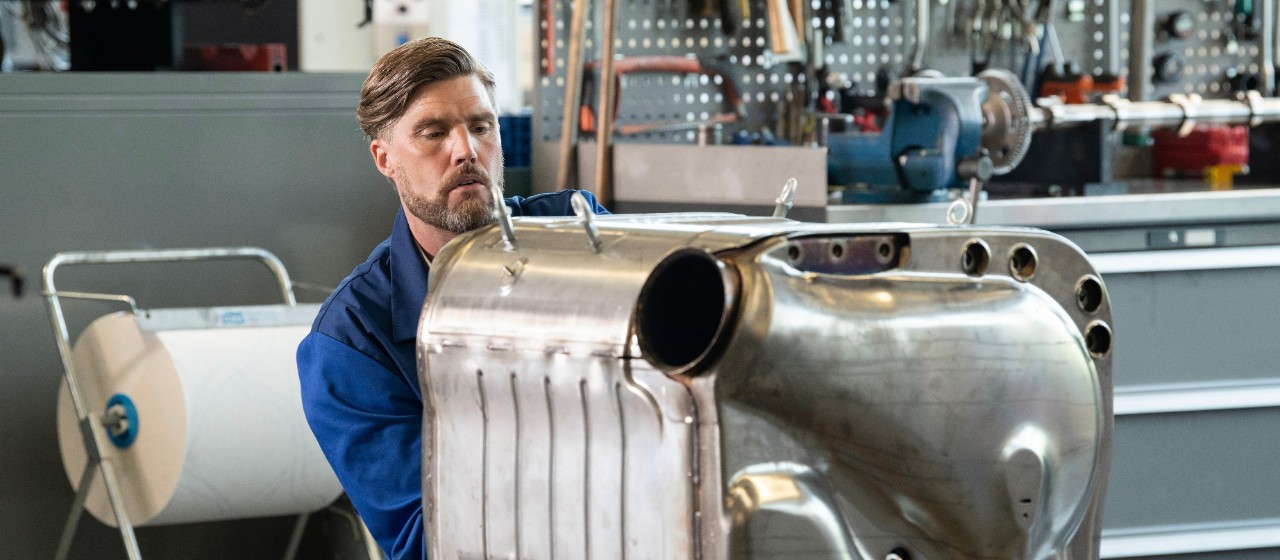
The beating heart of the new powertrain
12 JANUARY 2021
For the past five years, Scania’s super-dedicated R&D teams have turned over every stone to develop the most energy-efficient and sustainable combustion engine platform the heavy transport industry has ever seen. Here’s how they came up with the super-efficient Scania Super.
How do you improve an engine platform that has won the European Green truck award five years in a row? How do you develop a powertrain that will strengthen Scania’s industry-leading position within sustainable transport for the rest of this decade? How do you secure wins in future fuel consumption tests, an area in which Scania has a proud record that it doesn’t want to lose?
The developers at Scania Technical Centre who were given these assignments say the answers are: determination, innovation and customer focus.
Completely new platform
“We had the privilege to start with a blank slate and develop a completely new 13-litre engine platform,” says Assistant Chief Engineer Linda Pukk Berggren.
“Starting from scratch meant we could concentrate all our design work with the customers’ needs in focus, without restraints. That’s why we can now present a product that the transport industry really needs here and now to take the necessary steps towards a sustainable future,” she adds.
Assistant Chief Engineer Linda Pukk Berggren with team member Hubert Herbst.
With the Super engine platform, Scania’s engineers struck the perfect (and delicate) balance between a high-performing engine and an aftertreatment system that is as efficient as possible in limiting emissions but at the same time is “non-intrusive” for the engine and lets it fulfil its potential.
“We reach up to 50 percent in brake thermal efficiency. This is quite remarkable and means that a whole new level of energy is going directly to the wheels. What is also important is that fuel consumption is significantly reduced for a very broad part of the engine speed and load area. This means that many different applications, such as long-haul, construction and forestry vehicles, will all benefit from the improvements and emit less CO2,” says Magnus Nilsson, Technical Manager within Aftertreatment.
Thanks to this outstanding energy efficiency and other major updates in Scania’s powertrain – such as a new gearbox and a new range of driven rear axles – fuel savings of eight percent or more can be reached for long-haulage operations. And that’s in comparison with Scania’s already industry-leading performance levels. Efficient just became super-efficient.
“We couldn’t believe the data”
So, what’s ‘under the hood’ of the new 13-litre engine? Quite a lot, in fact.
New features include dual over-head camshafts, optimised injectors, improved combustion, an optimised high-pressure fuel pump, improved cooling and lubrication, increased turbocharger efficiency, and a state-of-the-art engine management system.
Not only that; Scania’s successful dual dosing Selective Catalytic Reduction system, which has been proven to offer excellent fuel saving capacity and increased productivity and uptime, has been remade from the ground up. The system has earned a name of its own: Scania Twin SCR.
“Our new Twin SCR aftertreatment system is an inventive ‘chemical factory’ designed to utilise the limited heat that exits the efficient engine. It is capable of dramatically reducing emissions of nitrogen oxides and particulates. The concept is also future-proof for stricter environmental legislation in the years ahead,” says Nilsson.
Dual over-head camshafts and SCR-only
Both Nilsson and Pukk Berggren say they have vivid memories of the five-year long development process. And, at more than two billion euros, it is one of Scania’s largest-ever investments in a new powertrain.
In 2019, Nilsson says the developer teams were quite puzzled when testing trucks with the new engine platform in the heat and high altitude of the Sierra Nevada mountains in southern Spain. The data indicated a significant reduction in fuel consumption of approximately ten percent in some tests – compared to the current award-winning Scania product that will be replaced by the new platform.
“We were fault-checking the test equipment because we questioned the readings, especially as the exhaust flow was comparatively low. Exhaust flow is an important parameter for designing the aftertreatment system and for the catalyst sizing. The higher the exhaust flow rate, the shorter time the catalyst can use to reduce the emissions. The experiments were re-run and confirmed in test cells at R&D in Södertälje. And we realised: the new engine was that good; we actually achieved this significant reduction of mass flow and, more importantly, fuel during the tests,” says Nilsson.
For her part, Pukk has fond memories of driving the test trucks down to southern Spain.
“The feel of the trucks and the new powertrain was absolutely amazing. I couldn’t believe how quiet and smooth it was to drive the truck. It’s a personal memory that will stay with me forever,” she says.
Scania’s new 13-litre engine platform
• 13-litre, inline six Euro 6 engine platform with four different power output levels for Euro 6: 420, 460, 500 and 560 hp.
• All engines have inherent HVO capabilities. Two of them can be ordered as FAME biodiesel versions.
• Extremely energy efficient; Brake Thermal Efficiency (BTE) of up to 50 percent, a number that used to be out of reach for combustion engines.
• Scania Twin SCR-system with significantly improved emission control.
• Dual overhead camshafts.
• In total, Scania’s new powertrain promises fuel savings that will typically reach 8 percent in long-haulage applications.